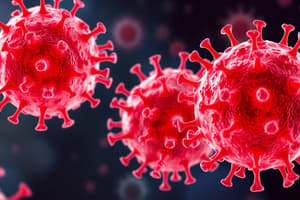Podcast
Questions and Answers
What defines a hypersensitivity reaction and how does it differ from a normal immune response?
What defines a hypersensitivity reaction and how does it differ from a normal immune response?
A hypersensitivity reaction is an exaggerated immune response to harmless antigens, unlike a normal immune response that is proportionate and protective.
Describe the role of immunoglobulin E (IgE) in Type I hypersensitivity reactions.
Describe the role of immunoglobulin E (IgE) in Type I hypersensitivity reactions.
IgE binds to mast cells, triggering immediate allergic reactions upon re-exposure to the sensitizing antigen.
Explain the significance of atopy in Type I hypersensitivity reactions.
Explain the significance of atopy in Type I hypersensitivity reactions.
Atopy refers to a genetically determined predisposition to allergic reactions, often leading to conditions like asthma and allergic rhinitis.
Compare Type I and Type II hypersensitivity reactions in terms of their pathogenesis.
Compare Type I and Type II hypersensitivity reactions in terms of their pathogenesis.
What types of antigens can trigger hypersensitivity reactions, and how are they categorized?
What types of antigens can trigger hypersensitivity reactions, and how are they categorized?
Outline the role of TH2 lymphocytes in allergic responses associated with Type I hypersensitivity.
Outline the role of TH2 lymphocytes in allergic responses associated with Type I hypersensitivity.
What is the clinical relevance of distinguishing between different types of hypersensitivity reactions?
What is the clinical relevance of distinguishing between different types of hypersensitivity reactions?
How does family history influence the likelihood of developing atopy and associated allergic diseases?
How does family history influence the likelihood of developing atopy and associated allergic diseases?
What are the clinical manifestations of localized hypersensitivity reactions like hay fever?
What are the clinical manifestations of localized hypersensitivity reactions like hay fever?
What role do IgG and IgM antibodies play in Type II hypersensitivity reactions?
What role do IgG and IgM antibodies play in Type II hypersensitivity reactions?
Describe the process of opsonization in Type II hypersensitivity reactions.
Describe the process of opsonization in Type II hypersensitivity reactions.
How does the complement system contribute to the effects of Type II hypersensitivity?
How does the complement system contribute to the effects of Type II hypersensitivity?
What are some clinical examples of complement-mediated inflammation in Type II hypersensitivity?
What are some clinical examples of complement-mediated inflammation in Type II hypersensitivity?
What is erythroblastosis fetalis and its mechanism related to Type II hypersensitivity?
What is erythroblastosis fetalis and its mechanism related to Type II hypersensitivity?
Explain how drug reactions can trigger Type II hypersensitivity.
Explain how drug reactions can trigger Type II hypersensitivity.
Identify the role of macrophages and neutrophils in Type II hypersensitivity reactions.
Identify the role of macrophages and neutrophils in Type II hypersensitivity reactions.
What role does Immunoglobulin E (IgE) play in the mechanism of Type I hypersensitivity reactions?
What role does Immunoglobulin E (IgE) play in the mechanism of Type I hypersensitivity reactions?
How does the early phase of a Type I hypersensitivity reaction differ from the late phase?
How does the early phase of a Type I hypersensitivity reaction differ from the late phase?
What are the primary effector cells involved in Type I hypersensitivity reactions and their roles?
What are the primary effector cells involved in Type I hypersensitivity reactions and their roles?
What clinical manifestations are associated with systemic anaphylactic reactions?
What clinical manifestations are associated with systemic anaphylactic reactions?
Which cytokine is most potent in activating eosinophils during the late phase of hypersensitivity reactions?
Which cytokine is most potent in activating eosinophils during the late phase of hypersensitivity reactions?
List some exogenous environmental antigens that can trigger Type I hypersensitivity reactions.
List some exogenous environmental antigens that can trigger Type I hypersensitivity reactions.
What happens to mast cells upon re-exposure to the same allergen in sensitized individuals?
What happens to mast cells upon re-exposure to the same allergen in sensitized individuals?
How do leukotrienes and prostaglandins contribute to Type I hypersensitivity reactions?
How do leukotrienes and prostaglandins contribute to Type I hypersensitivity reactions?
Flashcards
Hypersensitivity Reactions
Hypersensitivity Reactions
A heightened immune response to typically harmless antigens, leading to an exaggerated reaction.
Type I Hypersensitivity
Type I Hypersensitivity
An abnormal immune response involving the production of IgE antibodies, which bind to mast cells and release histamine upon contact with the allergen.
Atopy
Atopy
A term for individuals who have a genetic predisposition to developing allergies, often showing elevated IgE levels in their blood.
Anaphylactic Reaction
Anaphylactic Reaction
Signup and view all the flashcards
Type II Hypersensitivity
Type II Hypersensitivity
Signup and view all the flashcards
Blood Group Incompatibility
Blood Group Incompatibility
Signup and view all the flashcards
Autoimmune Reactions
Autoimmune Reactions
Signup and view all the flashcards
Immunodeficiency
Immunodeficiency
Signup and view all the flashcards
Allergen
Allergen
Signup and view all the flashcards
Immunoglobulin E (IgE)
Immunoglobulin E (IgE)
Signup and view all the flashcards
Mast cells
Mast cells
Signup and view all the flashcards
Anaphylaxis
Anaphylaxis
Signup and view all the flashcards
Early phase reaction
Early phase reaction
Signup and view all the flashcards
Late phase reaction
Late phase reaction
Signup and view all the flashcards
Histamine
Histamine
Signup and view all the flashcards
Hemolytic Transfusion Reaction
Hemolytic Transfusion Reaction
Signup and view all the flashcards
Hemolytic Disease of the Newborn
Hemolytic Disease of the Newborn
Signup and view all the flashcards
Autoimmune Anemia
Autoimmune Anemia
Signup and view all the flashcards
Autoimmune Disease
Autoimmune Disease
Signup and view all the flashcards
Complement- and Fc Receptor-mediated Inflammation
Complement- and Fc Receptor-mediated Inflammation
Signup and view all the flashcards
Complement-mediated Lysis
Complement-mediated Lysis
Signup and view all the flashcards
Opsonization and Phagocytosis
Opsonization and Phagocytosis
Signup and view all the flashcards
Study Notes
Types of Immune Response: Type I & II Hypersensitivity Reactions
- Hypersensitivity reactions are exaggerated responses to harmless antigens, resulting from an imbalance between effector and regulatory mechanisms.
- Individuals are considered sensitized if they have been previously exposed to the antigen.
- Types I, II, and III hypersensitivity reactions are immediate, occurring within 24 hours. Type IV is a cellular reaction, developing over several days.
- Type I Hypersensitivity (Atopy/Allergy):
- A rapid response triggered by an antigen binding to IgE antibodies on mast cells in sensitized individuals.
- Also known as anaphylactic reaction.
- Involves an abnormal adaptive immune response that may or may not involve antigen-specific IgE.
- Type II Hypersensitivity (Cytotoxic Hypersensitivity):
- Antibodies target antigens on cell surfaces or in the extracellular matrix, leading to cell destruction, inflammation, or impaired function.
- Can be caused by exogenous antigens (e.g., microbes, parasites, drugs) or endogenous antigens (e.g., in autoimmune diseases).
- Antibodies like IgG and sometimes IgM are involved.
- Effector cells include macrophages, neutrophils, eosinophils, and NK cells.
- Three mechanisms are: opsonization and phagocytosis, complement and Fc receptor-mediated inflammation, and antibody-mediated cellular dysfunction.
Clinical Examples of Type I Hypersensitivity
- Systemic anaphylactic reaction (anaphylactic shock): A potentially fatal reaction to allergens.
- Localized hypersensitivity: Reactions localized to the site of allergen entry, such as hay fever (allergic rhinitis), bronchial asthma, food allergies, atopic dermatitis, and allergic conjunctivitis.
Clinical Examples of Type II Hypersensitivity
- Hemolytic transfusion reaction: Mismatched blood transfusions triggering the destruction of blood cells.
- Hemolytic disease of the newborn (erythroblastosis fetalis): Maternal antibodies attacking fetal red blood cells due to Rh incompatibility.
- Autoimmune anemia: Antibodies attacking the body's own red blood cells.
- Drug reactions: Immunological reactions to drugs.
Studying That Suits You
Use AI to generate personalized quizzes and flashcards to suit your learning preferences.
Related Documents
Description
This quiz delves into the intricacies of Type I and II hypersensitivity reactions, highlighting their mechanisms and significance in the immune response. Understand the differences between anaphylactic reactions and cytotoxic hypersensitivity, as well as the role of antibodies and antigens. Perfect for students studying immunology and related fields.




